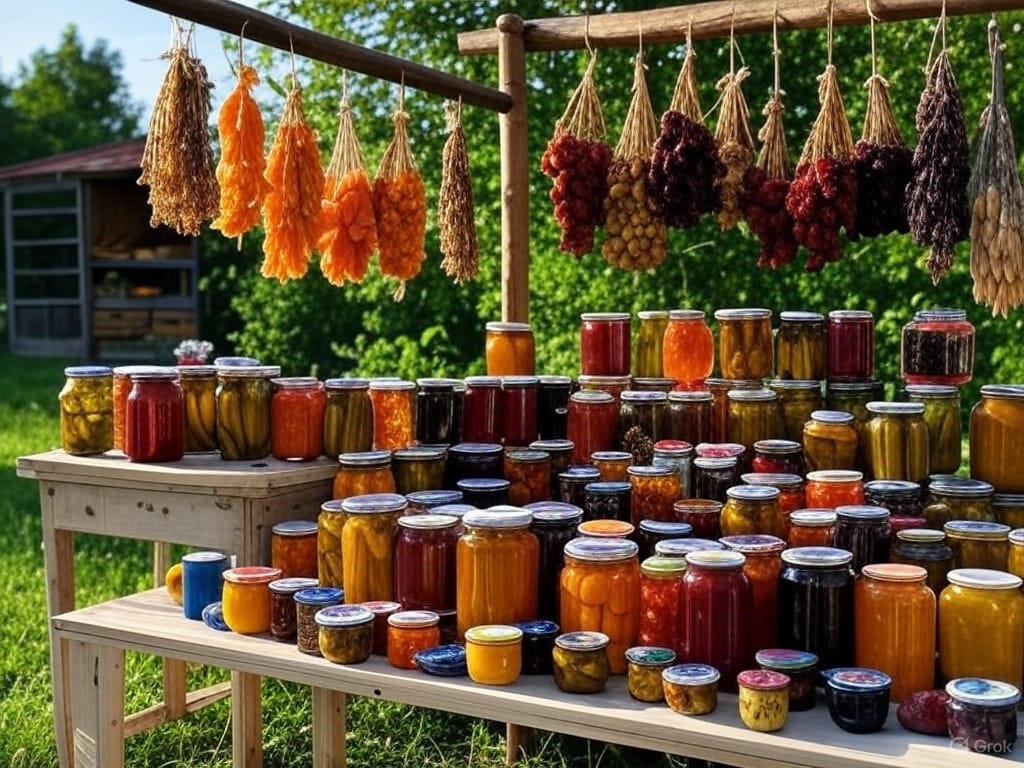From Seed to Storage
Food preservation, through canning, drying, and seed saving, transforms fleeting harvests into lasting resources, fostering self-sufficiency and sustainability.

In an era where self-sufficiency is increasingly valued, mastering food preservation is a vital skill for homesteaders, gardeners, or anyone seeking to reduce reliance on grocery stores. This guide explores three cornerstone methods of long-term food preservation: canning, drying, and seed saving. Each technique ensures your harvest remains flavorful, nutritious, and available year-round, fostering sustainability and security. Below, we outline the main principles of these methods without specific examples, focusing on their core concepts.
The Value of Food Preservation
Preserving food extends beyond prolonging shelf life—it captures the essence of your labor and the seasons. A well-preserved harvest minimizes waste, saves resources, and provides security for times of scarcity or emergencies. By mastering these time-tested methods, you create a sustainable cycle, rooted in traditions that predate modern refrigeration, empowering you to control your food supply and enjoy your harvest long after the growing season.
Canning: Preserving Freshness
Canning preserves food by sealing it in airtight containers and heating them to eliminate harmful microorganisms, ensuring long-term storage. The process involves preparing food, packing it into sterilized containers, and processing them using heat to create a vacuum seal. The method varies based on food acidity: high-acid foods require simpler heat processing, while low-acid foods need higher temperatures to prevent spoilage risks like botulism. Proper equipment, precise temperatures, and adherence to tested guidelines are critical for safety and longevity.
Drying: Concentrating Flavor
Drying, or dehydrating, removes moisture from food to prevent the growth of bacteria, yeasts, and molds, creating lightweight, shelf-stable products. The process involves exposing food to controlled heat and airflow, transforming it into a concentrated form that retains most nutrients. Drying methods rely on consistent temperatures and proper ventilation to ensure even moisture removal. Once dried, food must be conditioned and stored in airtight containers to maintain quality, offering a space-efficient preservation option.
Seed Saving: Sustaining the Cycle
Seed saving ensures future harvests by collecting and storing seeds from healthy plants, fostering a self-sufficient food system. The process involves selecting seeds from robust, desirable plants, ensuring they mature fully, and cleaning them to remove debris or moisture. Proper drying and storage in cool, dry conditions are essential to maintain seed viability. By prioritizing open-pollinated varieties and preventing cross-pollination, seed saving supports biodiversity and adapts crops to local conditions.
Building a Sustainable Pantry
Combining canning, drying, and seed saving creates a comprehensive system for food security. A well-organized pantry, stocked with preserved goods and seeds, ensures year-round access to nutritious food and planting resources. Regular monitoring and rotation of stored items maintain quality and prevent waste. Preservation efforts should align with harvest peaks for efficiency, creating a seamless cycle from garden to table.
Embracing Preservation as Art and Science
Food preservation blends precision with creativity, transforming fleeting harvests into lasting resources. By mastering canning, drying, and seed saving, you connect to ancestral wisdom while building resilience for the future. Each preserved item reflects ingenuity, ensuring your efforts endure beyond the season.





